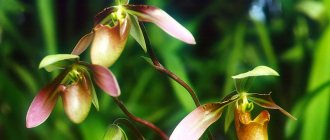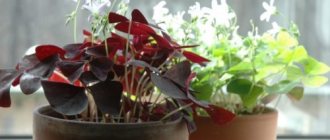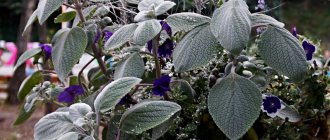Orchids are outstanding domesticated plants. Their beauty and grace are unique, and minimalism combined with magnificent flowering leaves no one indifferent. Since the century before last, many species were brought to Europe that perfectly adapted to home living conditions. A special place is occupied by the genus Paphiopedilum or slipper orchid.
The unusual appearance makes this flower very popular. In this article we will talk about caring for Paphiopedilum at home.
general information
This type of orchid is considered to be an unpretentious flower to care for. The Paphiopedilum orchid belongs to the Cipripediaceae family. The name comes from the word Paphos - this is the city, according to ancient Greek legends, the homeland of the goddess Venus; this flower is also called Venus's slipper. The homeland of this beautiful plant is the Indian subtropics. In nature, this orchid often grows on or between fallen or felled trees. The external structure of this plant is simple - a rosette of leaves and a root system.
Variety of species
There are about a dozen species of Paphiopedilum in stores that sell orchids. Here are the main types of Paphiopedilum:
- Paphiopedilum appletonianum (Appleton's) is a large hybrid up to 40 centimeters high with beautiful and fragrant green-purple flowers. Their diameter reaches 10 centimeters. The marbled pattern is very clearly visible on the leaves; they are belt-shaped. This beautiful orchid usually blooms in spring.
- Paphiopedilum Maudiae (Paphiopedilum Maudi) is the first hybrid that has become very popular among gardeners. The leaves are collected in neat rosettes with a checkered pattern. The flower also has stripes and is large, about 10 centimeters in diameter. It is usually white, but now there are hybrids with wine-red flowers. Its hybrid, Paphiopedilum americana, is also in great demand.
- Paphiopedilum Emerson is a small hybrid up to 20 centimeters high, but with one very large flower, 8 to 11 centimeters in diameter. The lip is orange-yellow, and the lip itself is white. The leaves of this species reach a length of 25 centimeters and are light green.
- Paphiopedilum bellatulum (bellatulum) - was discovered in 1888 in India. Its leaves grow up to 15 cm in length and 5 cm in width. Their lower surface is purple and their upper surface is covered with dark spots. The flowers are large, up to 9 cm in diameter. There can be up to 2 pieces. Usually one. The colors of the flowers range from white to pale yellow. With brownish-purple specks.
- Paphiopedilum niveum has variegated green leaves, the color of their lower surface is burgundy. The peduncle reaches 20 cm in height and one white flower with barely noticeable specks blooms on it.
Flower care
Paphiopedilums are not very capricious orchids, but caring for them at home still requires attentiveness and stability from the owner. You cannot leave your pet unattended for a long time. Her health is constantly monitored and involved in every stage of her life.
Temperature and lighting
Paphiopedilum species' temperature preferences vary. There are heat-loving species and those that are accustomed to moderate temperatures. All flowers with variegated foliage love warmth. Bellatulum is a cold-resistant species.
For heat-loving species, summer temperatures vary between 23-28 degrees, and winter temperatures, between 18 and 23. The daily temperature difference must be maintained at 5 degrees. Representatives that are adapted to lower temperatures, for example, bellatulum, prefer temperatures up to 22 degrees in the summer and develop well at 17 degrees in winter.
Important. Constantly high and constantly low temperatures are detrimental to red slippers. They cause diseases of the root system, yellowing of foliage and ultimately death.
Representatives of the Cypripediaceae family grow well in the shade, but if the owner of the beauty wants his red shoe to bloom and delight with rapid development, then it is better to organize diffused lighting. The optimal daylight hours are considered to be 14 hours. During the flowering period, Paphiopedilums are very demanding on the amount of light. In winter, additional lighting is provided.
Important. If the flower does not have enough light, then it will wither and stop developing. There will be a period of rest, the way out of which can be provided by additional lighting.
Watering Paphiopedilum
The Lady's slipper orchid loves water. Under no circumstances should the soil be allowed to dry out completely. As with other representatives of the orchid family, watering rules imply carefully applying water to the surface of the substrate, and not to the growth point, which can lead to rotting of the root system. Water from a fine-stream watering can is evenly applied to the surface of the soil until water begins to flow from the holes in the container. The next watering is carried out when the soil becomes barely damp to the touch, but not dry .
Important. After surface watering, carefully wipe all the axils of the leaves so that no moisture remains there, because this leads to rotting.
One of the most successful ways to water these flowers is watering through a tray:
The container with Paphiopedilum is placed in a tray with water. With this method of irrigation, the quality of the drainage system and the composition of the soil play an important role. If the soil is moisture-absorbing, then the watering time is approximately 60 minutes, if not, then about 15.
Humidity
Originally from tropical forests, the Venus flower loves humid climates. At home, it is not so easy to organize humidity at 70-80%, especially in winter, because the heating is on, which dries out the air greatly. But there is a way out. You can use humidifiers, or place the flower and pot in a wide container filled with damp material, such as moss.
Important. Humidity is measured with a device called a psychrometer. There are 2 thermometers on it, one of which shows the room temperature, which is very convenient.
Soil and container
The main requirements for soil are its fineness. The ingredients should not include huge pieces of bark or large stones. Here are examples of compositions:
Simple:
- Charcoal – 1 part.
- Pine bark – 5 parts.
Average:
- Charcoal – 1 part.
- Moss – 2 parts.
- Pine bark and wood chips – 5 parts.
One more example:
- Pine bark – 5 parts.
- Moss – 1 part.
- Charcoal – 1 part.
- Expanded clay and pumice - drainage.
Important. Drainage is extremely important because it is what ensures the outflow of excess fluid. Good drainage properties also provide air access to the roots of the flower.
Since Paphiopedilums are semi-epiphytes, they can also be planted on a block. To do this, take a piece of wood, make a hole in the middle and attach a wire in it that will hold the flower. Then the piece is hung and the flower is fixed on it. The roots are carefully laid, sometimes covered with moss.
Important. With this method of strengthening the flower, the method of watering changes. It is carried out by spraying the roots.
A pot is chosen with transparent walls and holes on the bottom and sides. This provides visual control of root health and humidity in the container.
After Paphiopedilum blooms, it is recommended to completely cut off the peduncle, because representatives of this species usually produce new ones. However, do not remove the flower stalk immediately after flowering, because if it remains healthy for a while, the next phase of color will likely begin soon.
Pruning poinsettias at home
The first poinsettia pruning after purchase at home is waiting for the flower after the bright foliage rosettes have withered. Before the plant retires, it is pruned, leaving 3–5 healthy buds on each shoot. They will provide new growth and become the basis for future flowering. To rest, poinsettia is transferred to a cool, dry room. At a temperature of +14–16 °C, under the scattered rays of the sun, the pot remains for 2 months.
As long as there are no signs of awakening on the stems, poinsettia practically does not need watering. If the soil is moistened, then be very careful to cause rotting of the roots and above-ground parts.
In May, the dormant period of punchettia ends. The abandoned buds awaken. As soon as this happens, the pot is transferred to a warm, bright room and active watering is resumed, making sure that the top layer of soil dries out a little between procedures and that water does not accumulate in the tray under the pot.
In order for the flowering to be as lush and strong as possible, no more than 5–6 strong shoots should be left on the flower. In the future, the green parts of the flower can be pinched until August, when the rudiments of future inflorescences are laid at the ends of the shoots.
Parts of the stems that become unnecessary after pruning turn into excellent cuttings when propagating poinsettias at home.
Transplanting Paphiopedilum
This procedure causes severe stress to the plant, because the main method of propagation of this species is by dividing the bush. The plant must be well developed and completely healthy. Stages:
- Immediately after the flowering period, the resting phase begins. At this stage, it is necessary to visually assess the ability of the bush to divide. Each separated part must have at least 3 shoots and its own roots.
- Division. A sterilized and well-sharpened instrument is taken, which is used to cut off. The sections are rubbed with charcoal or treated with an antiseptic.
- Then the mother plant is strengthened in the middle of the old pot and covered with new soil, and the separated part is strengthened in a new container and also covered with substrate. You can pour it up to the growth point, but not higher
Important. The temperature after transplantation does not exceed 22 degrees. The first watering is carried out after 2 weeks.
Propagation by seeds
In some cases, it is possible to propagate Guzmania by seeds. They are sown by first washing them with potassium permanganate and drying them. They are usually planted in a special mixture of sphagnum or peat. The main thing is not to bury them, because they need sunlight.
The ideal temperature for germination is 25 degrees. The first shoots will appear 15 or 20 days after planting. You just need to ventilate the room in time and provide the seedlings with comfort.
Diseases and pests
Like all other representatives of the orchid family, the red slipper suffers from diseases and pests. Main diseases:
- Root atrophy. Due to improper watering and temperature.
- Yellowing of leaves. The reason is direct sunlight and very high temperatures.
- Root rotting. A very serious disease that can be treated by root sanitation and transplantation.
Main pests:
- Whitefly. Small white insects that are destroyed with insecticides. Venus's slippers are very sensitive to them.
- Thrips. Inconspicuous insects that form black spots on the foliage. Destroyed with insecticides.
- Scale insects. They create waxy shields above themselves, which look like white spots or tubercles. Treated by mechanical removal and treatment with insecticides.
In this article we talked about a beautiful type of orchid - Paphiopedilum.
Errors during cultivation
If you bought a Guzmania home, it would be good to know the correct care secrets. It is advisable to study in advance the main problems that beginners make.
- For example, why doesn't Guzmania bloom? It's simple - little watering and light. It is necessary to monitor these factors, and it will delight you with its blossoming.
- If the stem rots, the cause may be stagnation of liquid or excessive soil moisture.
- If a flower stops blooming too quickly, it is possible that moisture got on the inflorescences during spraying - this factor is the main problem with rapid flowering.
Advice! Before buying Guzmania in a store, you need to learn how to properly care for it in a pot. After purchase, it must be immediately transplanted into the prepared earthen mixture.
If you carefully follow all the above recommendations, then the exotic beauty will soon delight you with its beautiful and long-lasting blossoms.











